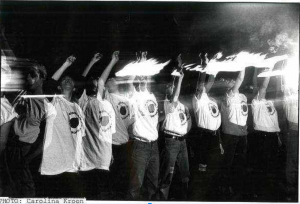Lesbian Avengers Eat Fire, Too (2013), Dir. Su Friedrich and Janet Baus
Lesbian Avengers Eat Fire, Too documents the 1992-1993 activities of a New York chapter of the lesbian direct action group the Lesbian Avengers. The film gives a sense of the flamboyant and unapologetic yet varied direct action tactics the group used, from eating fire at protests, to leaving stink bombs outside the office of a lawyer for a homophobic school superintendent and covering his office with “Homophobia Stinks” stickers, to protesting inside the office of SELF Magazine after the magazine planned a conference in Colorado, a state that had recently passed an anti-gay and -lesbian amendment. We see extended footage of the protest in favor of the multicultural Rainbow Curriculum; an anti-violence march and vigil in Greenwich Village following the murder of two gay people in Oregon at a time when Oregon had an anti-lesbian and -gay measure on the ballot; and of the Valentine’s Day installation of a statue of Alice B. Toklas, Gertrude Stein’s lover, next to the statue of Stein.
Formally, the documentary cuts back and forth between interviews with members of the organization, extensive footage of direct actions, and often hilarious clips of passers-by responding to the question, “Who do you think the Lesbian Avengers are?” The candid, conversational interviews, filmed during Avengers meetings, and the glee and raw power of the extensive protest footage combine to relay a sense of the explosive political energy of these lesbian activists, fed up with invisibility in women’s and gay movements and respectability politics among their fellow lesbians in this historical moment. Absent from the film is any overview of the group’s structure or sense of how the group was situated with respect to other queer activist groups. The film, directed by two Avengers, treats each action as a victory, and functions as a call to action, ending with the Avengers’ hotline number. The content of the interviews shown, which feature racially diverse lesbians, suggest that the group took an intersectional approach to; as one woman says, “Anything can be a lesbian issue.” However, critiques of the group by lesbians of color are given no screen time in this documentary.
Suggested Uses:
Because the documentary focuses exclusively on the Avengers, with little attention to coexisting groups of the era like OutRage! and ACT-UP, and because it presents no criticism of the Avengers, it is of limited use in conveying historical information. It would be more useful in conveying the mood of the group and in presenting a compelling case for the Avengers’ brand of activism. While it is necessarily one-sided, it could be an entry point into the women’s and gay movements in a high school history class, or in a college class focused on lesbian activism, if shown in concert with readings or films that offered other perspectives on the activism of the time. Or, watch it just for fun!
Bibliographic Item:
the march, off our backs: The radical feminist periodical off our backs documented the Avengers’ activities, including the inaugural Dyke March in Washington, DC.

